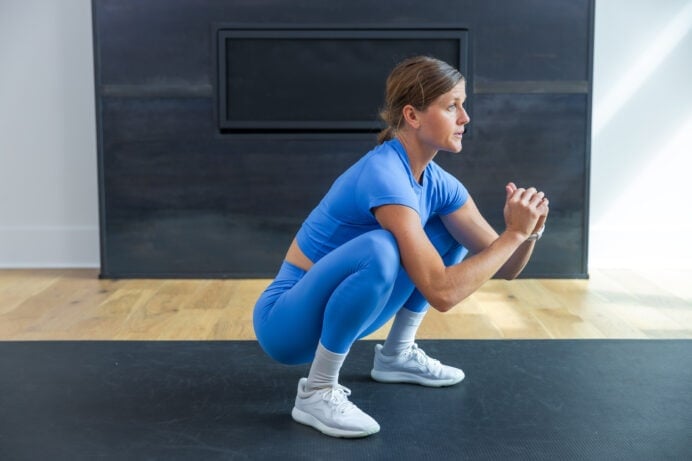
9 Best Compound Exercises (Full Body)
Build strength, increase endurance and improve total body conditioning with this full body workout: the nine best compound exercises with dumbbells. Compound exercises engage multiple muscle groups at once. This functional style of training is perfect for anyone with a busy schedule; hitting every major muscle group in around 30 minutes.
Focusing on compound lifts is one of the most effective ways to build strength in a limited amount of time.
Our most popular workouts, like the 7 Best Strength Training Exercises for Women, prioritize compound exercises, or exercises that engage multiple muscle groups simultaneously.
This not only saves time, but can also allow you to lift heavier weights (which promotes muscle growth), increase calorie-burn, improve core strength and stability, and build muscle.
Large, total body exercises get your heart rate up, while keeping the whole workout low impact.
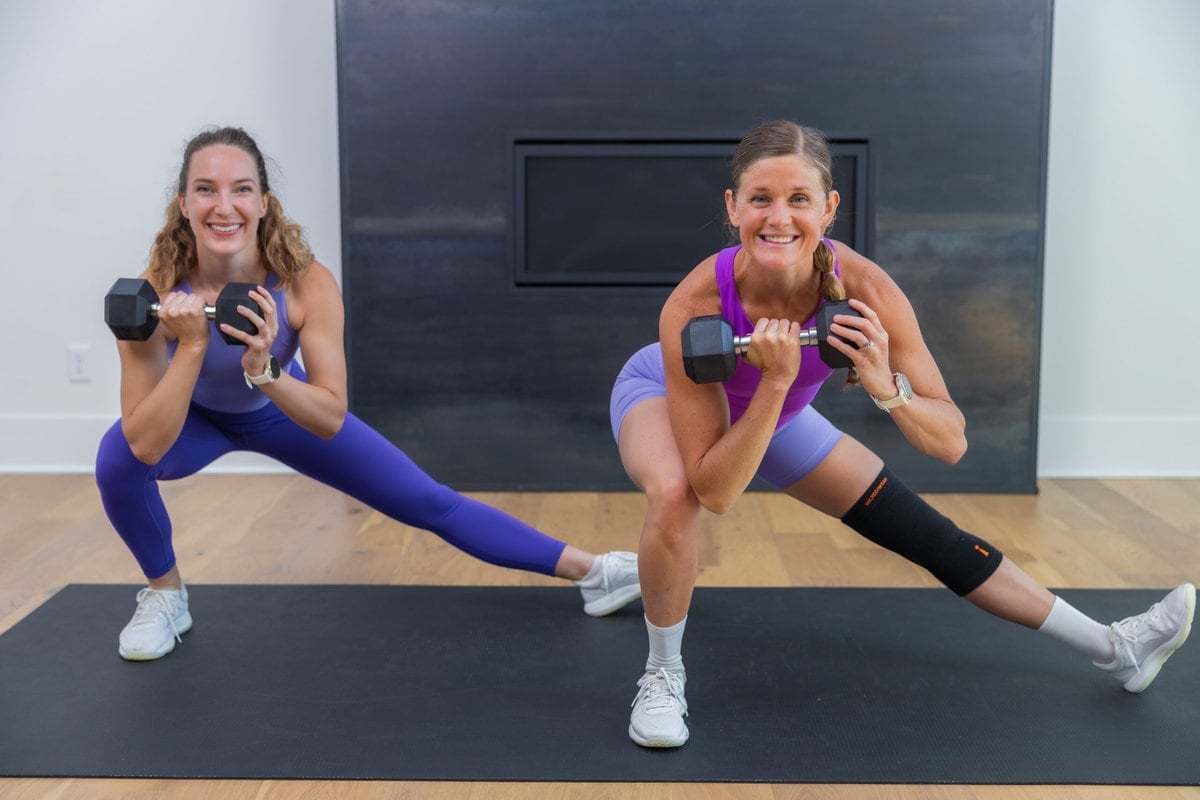
What Are Compound Exercises?
A compound exercise engages several different muscle groups to perform a lift or movement. For example, a squat engages the muscles in your glutes, quads, hamstrings, calves and core. Compound exercises are a form of functional strength training, building strength for the motions you perform every day, such as pressing, pushing, lifting and twisting. These multi joint exercises work more muscles at one time, giving you more bang for your buck in a short period of time.
9 Compound Exercises
Build total body strength with this efficient workout: the 9 Best Compound Exercises.
Each exercise engages multiple muscle groups at once. This functional style of training is perfect for anyone with a busy schedule; hitting every major muscle group in around 30 minutes.
Add full body workouts like this one to your workout routine 1-2 times a week to build muscle mass and increase endurance. Alternate full body exercises with dumbbell arm exercises and dumbbell leg exercises for the most efficient workout routine.
Workout Equipment:
Medium-to-heavy set of dumbbells. I’m using 15-20 lbs.
Workout Instructions:
Follow along with the guided Full Body Compound Workout on YouTube, led by certified personal trainer, Lindsey Bomgren.
Your Workout Looks Like This:
- 9 Compound Exercises
- Timed Intervals (perform each exercise for 40 seconds of work, followed by 20 seconds of rest)
- Repeat all 9 Compound Exercises x2 Sets
- 4-Minute AMRAP Finisher (repeating 4 dumbbell exercises from the workout as many rounds as possible – AMRAP – in 4 minutes)
Workout Outline
- Deadlift, Clean and Lateral Squat
- Balance Bicep Curl and Shoulder Press
- Lateral Squat and Clean
- Single Arm Row, Clean and Rotational Lunge
- Staggered Deadlift and Reverse Lunge
- Plank Row and Open to Side Plank
- Push Up and Burpee Get Up
- Single Leg Glute Bridge and Tricep Skull Crushers
- Dumbbell Snatches
4-Minute AMRAP Finisher
(10) Deadlift Clean and Squat
(10) Bent Over Back Rows
(10) Lunges
(10) Push Ups
9 Compound Exercises with Dumbbells
1. Deadlift, Clean and Lateral Squat
Targets: Lower body (glutes, hamstrings, hips, quads, calves), upper body (trapezius, deltoids, lower back), abs and core.
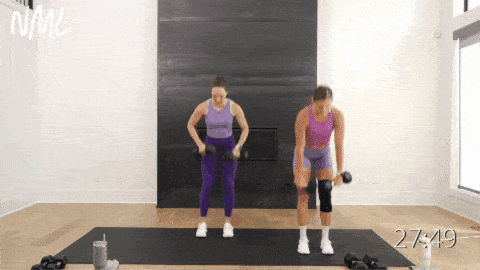
How To Do Deadlifts, Cleans and Lateral Squats
- Start standing, feet hip-distance apart and knees slightly bent. Hold a dumbbell in each hand in front of your thighs.
- Hinge forward at the hips to perform a deadlift, pushing your hips back as you lower the dumbbells down along the front of your body. Focus on keeping your back in neutral alignment with your neck and shoulders throughout the entire movement. Keep a slight bend in your knees.
- Then, drive through your heels to push your hips forward and squeeze your glutes as you return to a standing position.
- As you press your hips forward to stand up, “clean” the dumbbells up towards your shoulders. Catch the dumbbells at your chest in a front rack position.
- Then, step out to the right as you bend your knees, lowering into a squat. Push your knees out towards your outer three toes as your hips lower. Repeat twice, performing two lateral squats to the right.
- Then repeat, this time performing a deadlift, clean and two lateral squats to the left side.
2. Balance Bicep Curl and Shoulder Press
Targets: The biceps brachii (the front of your arms), shoulders, triceps, rear delts, upper back and core.
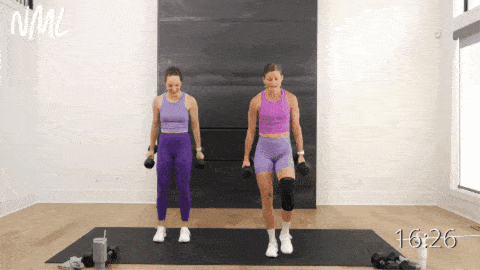
How To Do Balance Bicep Curls and Shoulder Presses
- Start standing, feet shoulder-width apart and core engaged. Hold a dumbbell in each hand at your sides, palms facing in towards each other (hammer curl).
- Transfer your weight to your left foot as you float your right knee, balancing on your left leg. Engage your core to protect your lower back.
- Then, perform a bicep curl, squeezing the front of your arm to curl the weights up to shoulder height. Think about keeping elbows tucked into your sides and shoulder blades pulled down. Repeat, performing two bicep curls.
- Then, perform a narrow overhead press by pushing the dumbbells overhead until your arms are fully extended, biceps near ears. Repeat, performing two shoulder presses.
- Slowly and with control, lower the dumbbells down to shoulder level. Then curl them down to your sides, returning to the start position.
- Return your floating right leg to the ground, then switch feet; balancing on your right leg and floating your left knee.
- Continue this pattern, alternating two balance bicep curls with two shoulder presses.
Modification: Keep both feet on the ground, omitting the balance portion of this exercise.
3. Lateral Squat and Clean
Targets: Gluteus medius (outer glute that controls hip movement and side-to-side movements), quads, inner thighs (or hip adductors), hamstrings, calves and core.
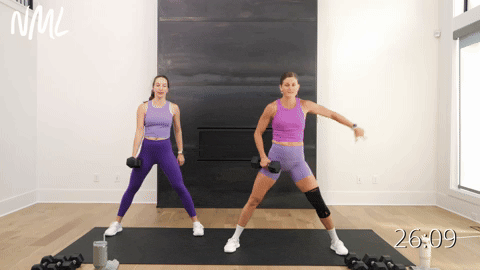
How To Do A Lateral Squat and Clean
- Start with your feet wider than your hips (think a wide squat stance), with your knees and toes pointing forward. Or toes just slightly turned out away from your body. Hold one dumbbell in your left hand.
- Shift your weight into your right heel as you push your hips back, bending your right knee while leaving your left leg straight. Think of performing a single leg squat with your right leg while your left leg remains straight.
- Then, drive through your right foot to reverse the movement, pushing you back up to center.
- Then alternate the movement, shifting your weight into your left heel as you transfer the dumbbell to your right hand and push your hips back, bending your left knee while leaving your right leg straight.
- Then, drive through your right foot to reverse the movement, pushing you back up to center.
- As you push back up to center, shift your weight into your right foot and perform a knee drive on the left foot, challenging your balance. As you do so, clean the dumbbell in your right hand up to shoulder height.
Modification: Omit the balance knee drive.
4. Single Arm Back Row, Clean and Rotational Lunge
Targets: Legs, glutes, quads, hamstrings, hip adductors, knee and ankle joints, lower back, lats and core.
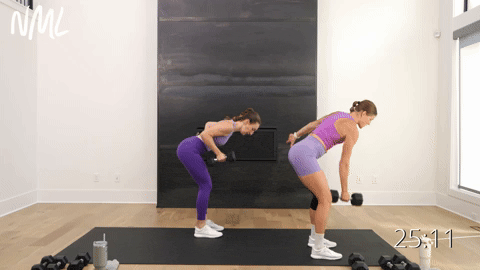
How To Do A Single Arm Back Row, Clean and Rotational Lunge
- Stand with feet hip width apart, knees slightly bent. Hold one dumbbell in your left hand at your hip, palm facing in towards your body.
- Hinge at the hips and perform a single arm back row on the left arm; pulling the weight back toward your left hip. Repeat for a second single arm back row.
- After the second back row, drive through the heels to push your hips forward, pulling the dumbbell up past your hips and cleaning it up to your left shoulder.
- Immediately step your left foot back, rotating your left toes and both hips 90 degrees to face the left wall. Right toes stay facing the front of the room.
- Bend your left knee and sit back towards your left hip, keeping your right leg straight. Think about performing a single leg squat on the left side. Right toes pop off the mat (toes up towards the ceiling).
- Then, drive off your bent left leg to reverse the movement, standing tall and facing the front of the room.
5. Staggered Deadlift and Reverse Lunge
Targets: Legs, glutes, hamstrings, quads, lower back and core.
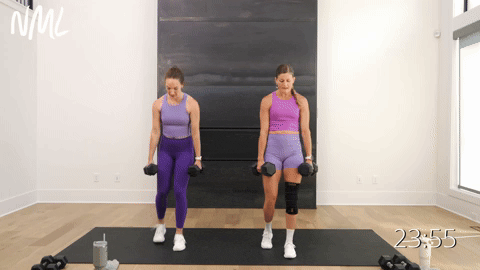
How To Do A Staggered Deadlift and Reverse Lunge
- Stand with feet hip-width apart, knees slightly bent. Hold a pair of dumbbells at your thighs (palms facing in towards your body).
- Stagger your feet, so your right leg is slightly in front of your left foot. Kickstand your back left foot, left heel floating off the ground. Keep 80% of your weight in your front foot, 20% in your back left toe.
- Maintain a staggered stance as you hinge at the hips. Pushing your hips back towards the wall behind you as you glide the dumbbells down the front of your leg; core tight.
- Drive through your front right heel to push your hips forward, pulling the dumbbells back up towards your hips as you stand tall. Repeat for a second staggered deadlift.
- Then, step your left leg back into a reverse lunge, lowering your hips until both knees reach a 90-degree angle, front thigh parallel to the floor.
- Then squeeze your right leg glute, driving your left leg forward as you stand up back to the starting position. Repeat for a second split lunge.
6. Plank Row and Open to Side Plank
Targets: Latissimus dorsi (or lats), upper back, chest, shoulders, arms and core (emphasis on obliques).
Your core stabilizes your hips as you pull the dumbbell overhead.
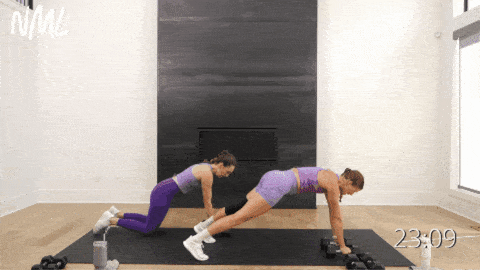
How To Do Plank Rows and Side Plank Opens
- Start in a high plank position, both hands on your dumbbells, shoulders stacked over wrists, core engaged.
- Perform a single arm plank row (or renegade row) on each side, pulling first your right elbow to right hip, then planting it on the ground and pulling left elbow to left hip before returning it to the ground.
- Then, holding the dumbbell in your right hand, open your upper body into a side plank towards the right. As you rotate open, pull the dumbbell in your right hand first across your chest and then extend overhead. Dumbbell is stacked directly over the right shoulder. Your body should look like a sideways “T” shape.
- Slowly and with control, lower the dumbbell to the mat, returning to a high plank position.
- Repeat, this time beginning with a plank row on the left side, then the right side, then opening to a “T” towards the left.
Modification: Take this move from your knees, or place your hands on a bench or chair to find a modified plank position.
7. Push Up and Burpee Get Up
Targets: Full body with an emphasis on the legs, hamstrings, hips, glutes, chest, shoulders, triceps, back, abs and core muscles.
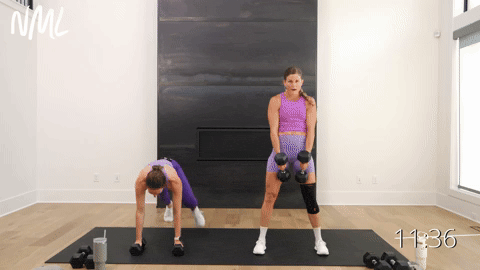
How To Do A Push Up and Burpee Get Up
- Start standing with your feet shoulder-width apart. Hold a pair of dumbbells at your sides (palms facing in).
- Hinge forward at the hips, pushing your hips back as you lower the dumbbells down the front of your body. You should feel a stretch in the back of your legs (hamstrings).
- Place the dumbbells on the ground in front of you (between your feet) and perform a burpee. Place your hands on the dumbbells and jump your feet back into a high plank position.
- Then perform a push up. Maintain a straight line with your body, gaze slightly in front of you as you slowly lower your chest down towards the ground. Elbows fall back towards your hips (not out to the sides).
- Once at the bottom of your push up, exhale as you push back up into high plank position. Repeat for a second push up.
- Then jump your feet back in, feet landing outside of the dumbbells.
- Grab the dumbbells and pull them up along your legs (as you would in a deadlift).
Modification: Perform modified push ups from your knees, and slow the burpee down by performing slow burpee step ins.
8. Single Leg Glute Bridge and Tricep Skull Crusher
Targets: Legs, glutes, hamstrings, inner thighs, triceps and core.
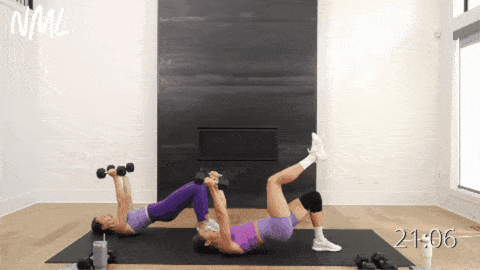
How To Do Single Leg Glute Bridges and Tricep Skull Crushers
- Start laying on your back, right foot planted flat on the ground, left foot extended overhead. Hold one dumbbell in each hand, fully extending your arms so the dumbbells are directly overhead, palms facing one another.
- Press through your heel to lift your glutes off the mat, squeezing your glutes as you lift. Think about keeping your core engaged and knees in line with your hips. Hold this single leg glute bridge.
- Bend at the elbows to slowly lower the dumbbells towards your head, performing a skull crusher.
- Then squeeze the back of your arm to straighten your elbows, pressing the dumbbells back overhead to return to the starting position.
Modification: Option to perform skull crushers while holding a double leg glute bridge (keeping both feet flat on the ground).
9. Dumbbell Snatches
Targets: Legs, hamstrings, hips, glutes, back, shoulders and deep transverse abdomen (core muscles).
The single arm dumbbell snatch is a compound exercise that works the full body and improves coordination, explosiveness and strength.
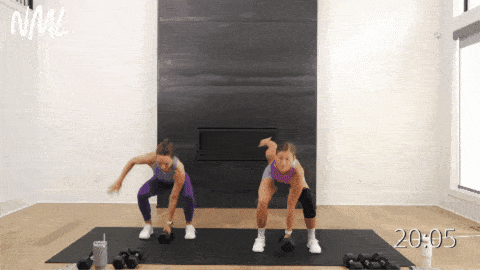
How To Do Dumbbell Snatches
- Start standing, feet shoulder-width apart, knees slightly bent. Place a dumbbell on the floor between your feet.
- Hinge forward at the hips, pushing your hips back towards the wall behind you as you lower down, reaching for the dumbbell with your right hand.
- Then, drive your hips forward as you ‘snatch’ the weight overhead with your right arm. Use the power and momentum created by your legs and hips to drive the weight overhead. You should finish standing tall with your right arm straight overhead, right bicep near your right ear.
- With control, lower the dumbbell back down to the ground, returning to starting position.
- Then repeat, this time performing a dumbbell snatch with your left hand.
Modification: Perform a dumbbell clean instead of a full snatch, catching the dumbbell at shoulder height.
FAQs
The best compound lifts are variations of squats, deadlifts, chest presses (or bench presses), shoulder presses (overhead presses), back rows and pull ups. These exercises can be done in a conventional gym with equipment such as benches and barbells, or at home using dumbbells.
Both compound exercises and more targeted isolation exercises have benefits and should be included in a well-rounded training program. One of the best benefits of compound exercises is that they are more efficient, meaning you can often lift heavier weights and burn more calories. Whereas isolation exercises (or exercises that focus on a specific muscle group, such as back exercises or chest exercises) can improve muscle definition and address muscle imbalances or weaknesses.
Yes, compound exercises are suitable for all fitness levels. That said, because compound exercises are complex, they should be performed with proper form and modifications should be made when necessary. Beginners can start with basic variations and progress to more advanced movements as their strength improves.
More Workouts
Full Body WorkoutsPin this Full Body Workout: The Best Compound Exercises
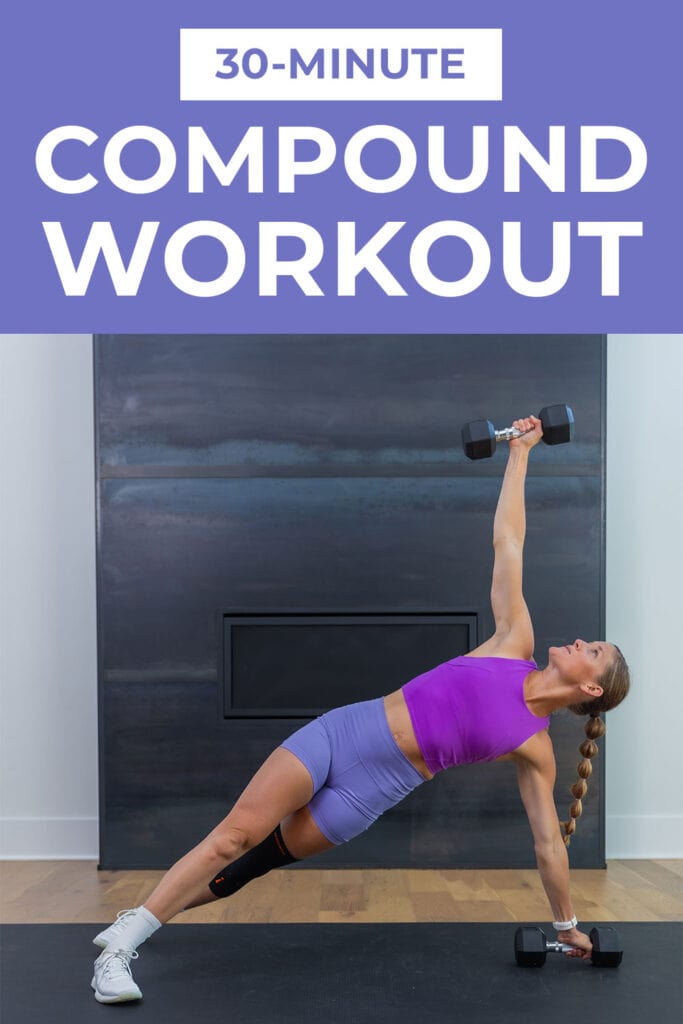
This post includes affiliate links. I do earn a commission for products purchased using these links (at no additional cost to you). Thank you for supporting Nourish Move Love, making the content you see on this blog possible.










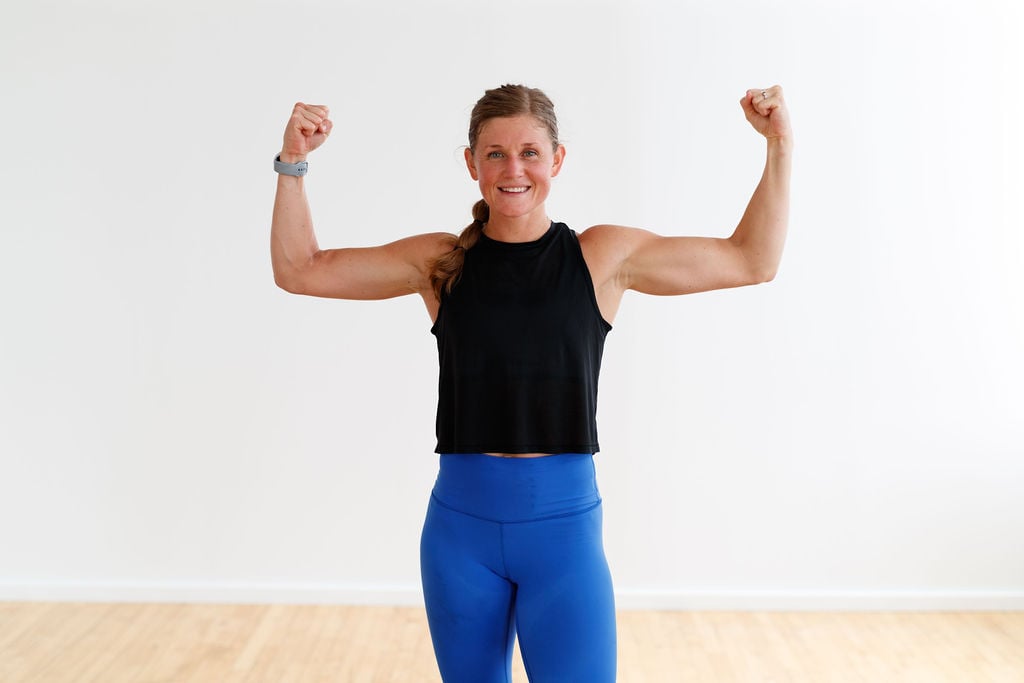
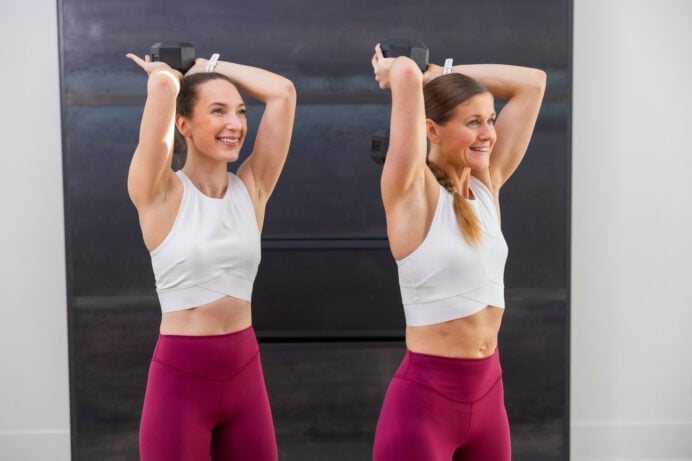
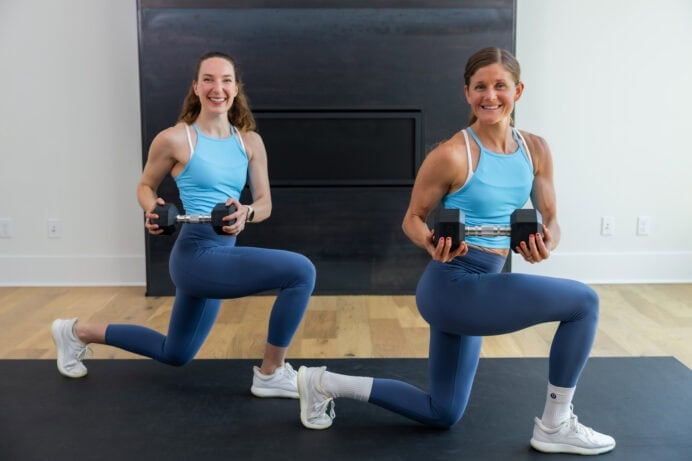

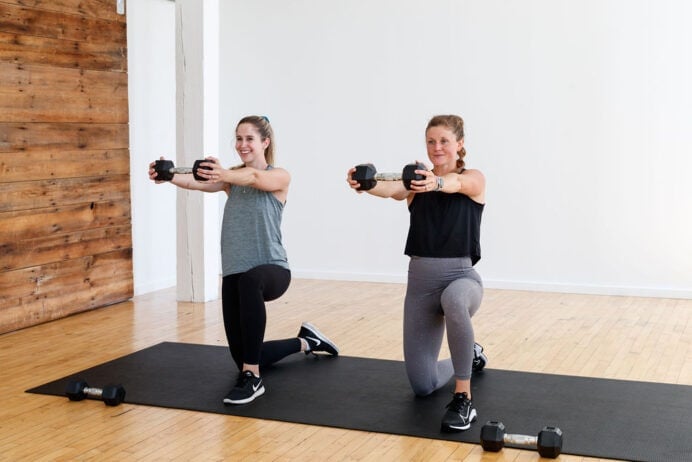
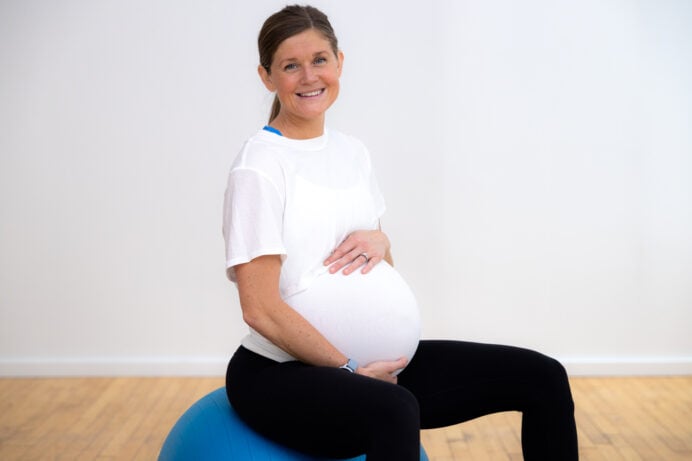
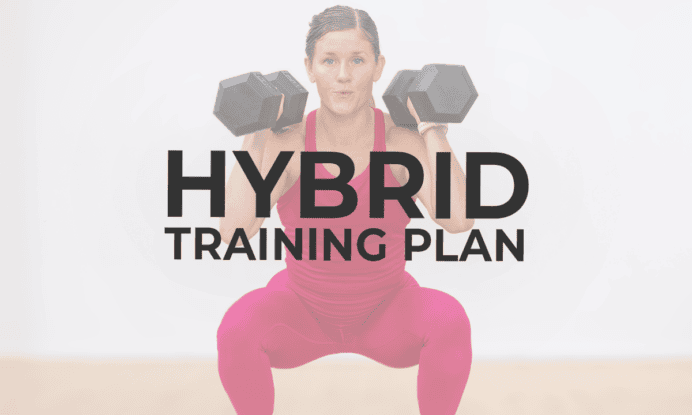
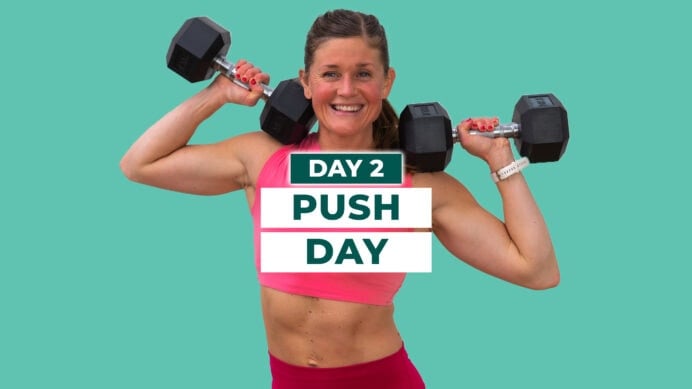
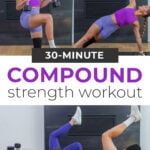
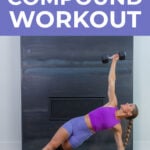
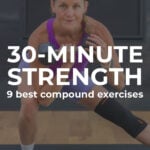
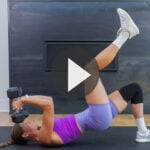

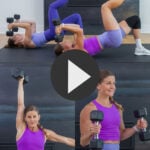
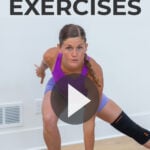
GREAT workout!!
Thank you thank you!!!!!!!
Tamara! So happy to hear you enjoyed this workout and I hope you come back for more! -Lindsey